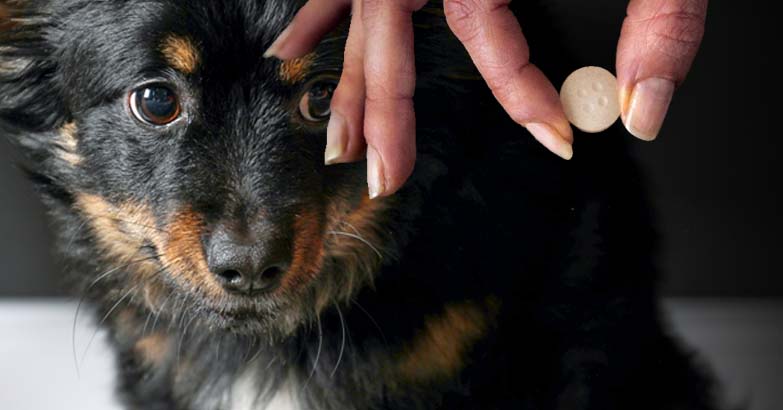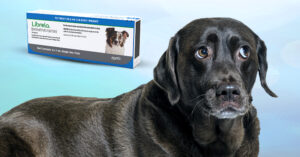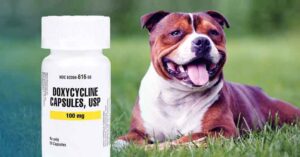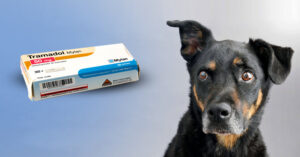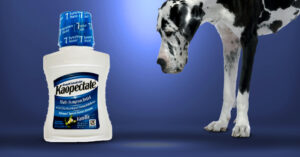Trifexis is a drug for dogs that’s achieved a wide degree of popularity … as well as notoriety. Despite being an FDA approved drug, many users have complained about side effects of Trifexis for dogs.
Trifexis is the #1 prescribed combo parasite protection … meaning it can protect against fleas, heartworms and intestinal worms. But just because something’s effective doesn’t mean it’s the safest choice for your dog.
So what’s the real scoop behind this chewable tablet? Read on to find out…
What is Trifexis? | Trifexis Chewable Tablets for Dogs
Trifexis is a drug that comes in flavored chewable tablets for dogs. It’s given monthly and is intended to protect dogs from parasites like heartworms, roundworms, hookworms, and fleas.
The drug comes in a beef-flavored tablet to be taken every month. The fact that Trifexis is a chewable tablet adds an extra level of convenience for many pet owners. It’s marketed as an “easy way” to give your dog his monthly dose of anti-parasite medication.
Trifexis is prescribed for…
- Killing fleas
- Preventing flea infestations
- Preventing heartworm disease
- Treating and controlling adult hookworm, roundworm, and whipworm infection in dogs (even though your dog may not even have worms)
Trifexis is a prescription medication. The manufacturer claims Trifexis is safe for dogs that are at least 8 weeks old. (Read more about the reported side effects of Trifexis below.)
What’s in Trifexis?
The active ingredients in Trifexis are intended to kill parasites like fleas and worms, and prevent heartworm disease. These ingredients are spinosad and milbemycin oxide. Spinosad
How Does Trifexis Work?
To understand how Trifexis works, here’s how its active ingredients affect parasites.
Spinosad and milbemycin oxide are insecticides that work by affecting the insect motor system and altering the motor neurons.
Spinosad is a member of the spinosyn class of insecticides, and is found in over 80 registered pesticide products. When insects eat or touch spinosad, their muscles begin to flex uncontrollably. Eventually, this leads to paralysis and death … usually within 1-2 days.
Trifexis’ other active ingredient, milbemycin oxide, works a bit differently but has the same basic effect. Milbemycin oxide works by binding to the chloride channels of parasites’ nerve and muscle cells. It forces these channels to stay open, which causes paralysis of the tissue, and eventually results in the death of the organism.
In Trifexis, spinosad is the active ingredient intended to kill fleas, while milbemycin oxide claims to kill hookworms, roundworms, and whipworms and prevent heartworm disease.
The fact that the drugs work by paralyzing the insects means that the active ingredients can cause some risky side effects in your dog.
Side Effects Of Trifexis For Dogs
The active ingredients in Trifexis have been linked to the following reported side effects. You’ll note that many of them involve neurological problems like convulsions or ataxia.
Milbemycin oxime
- Ineffective – heartworm larvae, ascarids, hookworms, whipworms
- Vomiting
- Diarrhea
- Depression/lethargy
- Anorexia
- Convulsions
- Ataxia
- Trembling
- Diarrhea, bloody
- Death
Spinosad
- Vomiting
- Depression/lethargy
- Ineffective – fleas
- Anorexia
- Puriritis
- Diarrhea
- Convulsions
- Trembling
- Ataxia
- Unpalatable, won’t eat
These side effects are especially troubling in an oral drug, because if your dog has a reaction, you can’t just stop it … the drug will remain in his system for at least 30 days. Many anecdotal reports from dog owners on social media blame Trifexis for seizures and other neurological problems in dogs.
What’s the Difference Between Trifexis Green, Brown, and Blue?
The recommended dosage for Trifexis depends on the size of the dog, so they organize their dosing recommendation by color. It starts with pink for small dogs 5-10 lbs, and goes all the way up to brown for large breeds of 60.1-120 lbs. If you do decide to use the drug, make sure your vet prescribes the right one for your dog’s size so you don’t give more than is needed.
Does Your Dog Need Trifexis?
Conventional veterinarians prescribe this drug for its convenience, because it’s so easy to give one pill a month to prevent fleas, intestinal worms and heartworm disease. But do you really need to do that every month, year round?
When it comes to pest preventive drugs, the oral ones are the riskiest category for your dog. There are many safer options you can read about in the article below.
RELATED: The safest flea and tick prevention for dogs …
In many climates, fleas and heartworms are only a seasonal risk, not year round. And while preventing them is desirable, remember Trifexis also kills intestinal worms … that your dog probably doesn’t have. There’s no reason to add unnecessary drugs to deworm your dog … unless he actually has worms.
Now you know the risks and reported side effects of Trifexis, if your veterinarian recommends the drug, think very carefully and do your research into safer alternatives before you give it to your dog.

